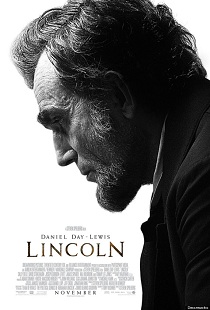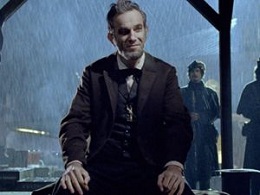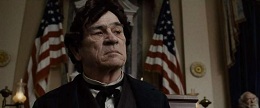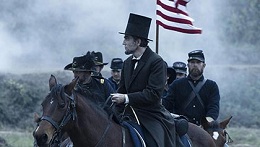 Steven Spielberg’s newest holiday Oscar-bait project, Lincoln, suffers under the burden of its own ambitious pretensions, for what it offers up in the acting department is often sabotaged by jagged pacing, uneven story-telling, and a redundant message.
Steven Spielberg’s newest holiday Oscar-bait project, Lincoln, suffers under the burden of its own ambitious pretensions, for what it offers up in the acting department is often sabotaged by jagged pacing, uneven story-telling, and a redundant message.
A bold project to be sure, and one Spielberg should be given credit for tackling in such a responsible fashion, yet Lincoln is only half the movie it could have been.
Now, that’s not to say that this is a bad movie: quite the opposite. It’s a damn fine one, especially for historians who have one or more degrees in American History, and would love nothing more than to spend two and a half hours watching the world’s greatest actor inhale and inhabit Abraham Lincoln. Again demonstrating his absolute and total commitment to the roles he takes up, Daniel Day-Lewis straight knocks it out of the park, and gives a far more thoughtful and restrained performance than what the film’s trailers suggest. Yet the film doesn’t give the actor very far to travel, for despite a hastily tacked-on ending that tries to give some definition to the larger events of the picture, Lincoln keeps a fairly tight focus.
 When the film starts with Day-Lewis’ Abraham Lincoln sitting slump-shouldered and fatigued before a group of black and white Union soldiers, one gets the sense that the man is tired. Though Spielberg begins the scene in flashback, offering up a few images of the savage fighting in Arkansas these soldiers speak of, he finally settles on Lincoln, who seems to be listening, exhausted, to a variation on a story he’s heard far too many times before.
When the film starts with Day-Lewis’ Abraham Lincoln sitting slump-shouldered and fatigued before a group of black and white Union soldiers, one gets the sense that the man is tired. Though Spielberg begins the scene in flashback, offering up a few images of the savage fighting in Arkansas these soldiers speak of, he finally settles on Lincoln, who seems to be listening, exhausted, to a variation on a story he’s heard far too many times before.
This fatigue is a consistent theme, and one that Day-Lewis conveys masterfully through his every motion. Indeed, each shrug, exhale, and head shake is laden with purpose and meaning, something that gives the audience a very keen sense of the President’s physical and emotional state throughout the entire film: the credit for which is due entirely to the actor and director in question.
Yet herein lies the movie’s biggest failing. Daniel Day-Lewis and his fellow actors do such an amazing job with their portrayals that it seems Spielberg didn’t want to do much else with his movie except wallow in their splendor. Tommy Lee Jones has already gotten a lot of positive marks for his portrayal of Thaddeus Stevens, and for damn good reason: it’s the part the man seems to have been born to play. The seasoned, idealistic, yet severely jaded old-dog politician seems to jump off the screen when Jones makes his appearances, and the work David Strathairn and long-time character actor Bruce McGill do as Seward and Stanton are a historical revelation.
 All of these actors do a wonderful job creating believable characters that are still remarkably close to the historical reality (Stanton did indeed hate Lincoln’s stories, and Seward was, in fact, a son of a bitch who was nevertheless handy in a pinch). And while some have quibbled with their posture in the film, claiming that Lincoln never really had “rivals” in his cabinet by this point in the war, the characterizations were certainly spot-on.
All of these actors do a wonderful job creating believable characters that are still remarkably close to the historical reality (Stanton did indeed hate Lincoln’s stories, and Seward was, in fact, a son of a bitch who was nevertheless handy in a pinch). And while some have quibbled with their posture in the film, claiming that Lincoln never really had “rivals” in his cabinet by this point in the war, the characterizations were certainly spot-on.
Yet by setting the film in 1865, after Lincoln’s re-election, and the most dramatic turns of the war, much of this work seems to have been wasted. Ostensibly about Lincoln’s push to pass the 13th Amendment through the House (the amendment to abolish slavery), Spielberg’s picture is, by-and-large, a political procedural. Although flashes of the war, and its active participants flitter in and out, the movie spends a majority of its time going over the lobbying and vote-swapping that went on behind the scenes in early 1865.
And that’s pretty much it.
If you’re a person who enjoys watching very precise, well-acted political dramas that deal with the passage of legislation (and this author counts himself among that exclusive number), then Lincoln will be right up your alley. If you’re looking for a fleshed-out, cinematic character study that gives you a better understanding of our nation’s 16th President and the Civil War over which he presided, then you may be somewhat disappointed, however. While there is some time given over to Lincoln’s personal life, and his relationship with his wife and sons (Sally Field is wonderful as the frantic, bi-polar Mary Todd Lincoln), there isn’t much new here.
 Historians, amateur Civil War buffs, and Lincoln lovers will delight in the small details Day-Lewis offers to give an accurate flavor to his Lincoln characterization, including cute particulars like his disdain of gloves and his proclivity to keep things in his hat, yet they may be disappointed at the lack of time given over to the man’s development, if only during his time as President. Indeed, instead of getting to know Abraham Lincoln, the audience is instead offered a finished product from which it must glean an understanding, and while Day-Lewis succeeds in that task, it would have been nice to see what he might have done with an expanded narrative scope.
Historians, amateur Civil War buffs, and Lincoln lovers will delight in the small details Day-Lewis offers to give an accurate flavor to his Lincoln characterization, including cute particulars like his disdain of gloves and his proclivity to keep things in his hat, yet they may be disappointed at the lack of time given over to the man’s development, if only during his time as President. Indeed, instead of getting to know Abraham Lincoln, the audience is instead offered a finished product from which it must glean an understanding, and while Day-Lewis succeeds in that task, it would have been nice to see what he might have done with an expanded narrative scope.
What’s worse, the Lincoln that Spielberg offers up doesn’t contrast much with the established understanding of the President as the great emancipator, one known to most schoolchildren and adults with even a casual grasp on mid-19th century American history. By starting the film with a battle featuring black soldiers, and using the fight over the 13th Amendment to frame the narrative, Spielberg has simply made another in a long line of Lincoln-the-Great pictures, one that succeeds in pinning down the President’s personality, yet fails to elucidate what made the man that way.
For a country that has just emerged from an especially divisive election, it seems like a discussion of what once nearly tore the United States apart, and what the President at that time did to keep it together, might be more than a little apt. Instead, audiences got Lincoln, a very well-acted film that tells a familiar story in only a slightly new way. It’s nothing daring, or new, but hey — nobody’s accused Spielberg of either of those things in a long, long time.
Historical Quibbles:
– The Capitol Dome is shown as completed and without scaffolding in January 1865, when it was in fact still under construction in parts, and not entirely painted as shown.
– When Lincoln is touring the aftermath of the Petersburg Siege, a Confederate battle flag is shown on a breastwork, flapping in the wind. During the Civil War, flags and regimental standards were highly-prized, and were sometimes even torn to pieces and distributed amongst a unit to keep it from falling into enemy hands. It is highly unlikely that one would be conspicuously waving, unclaimed, on a battlefield after a fight.
– Unless I’m missing something, and every book I have on the subject is as well, Robert Lincoln was not present at Lee’s surrender at Appomattox as indicated in the picture.





{ 2 comments }
STILL MORE done-to-death PC moral alibis from the
Hollywood franchise slum mafia.
There is absolutely nothing “limited scope” about Lincoln. It breathes with period and depth. Just because it’s not a Civil War spanning biopic doesn’t mean it lacks in anything.
It’s actually amazing how much it reveals about the title character, politics and psychology of that time. It is incredibly immersive.
Comments on this entry are closed.